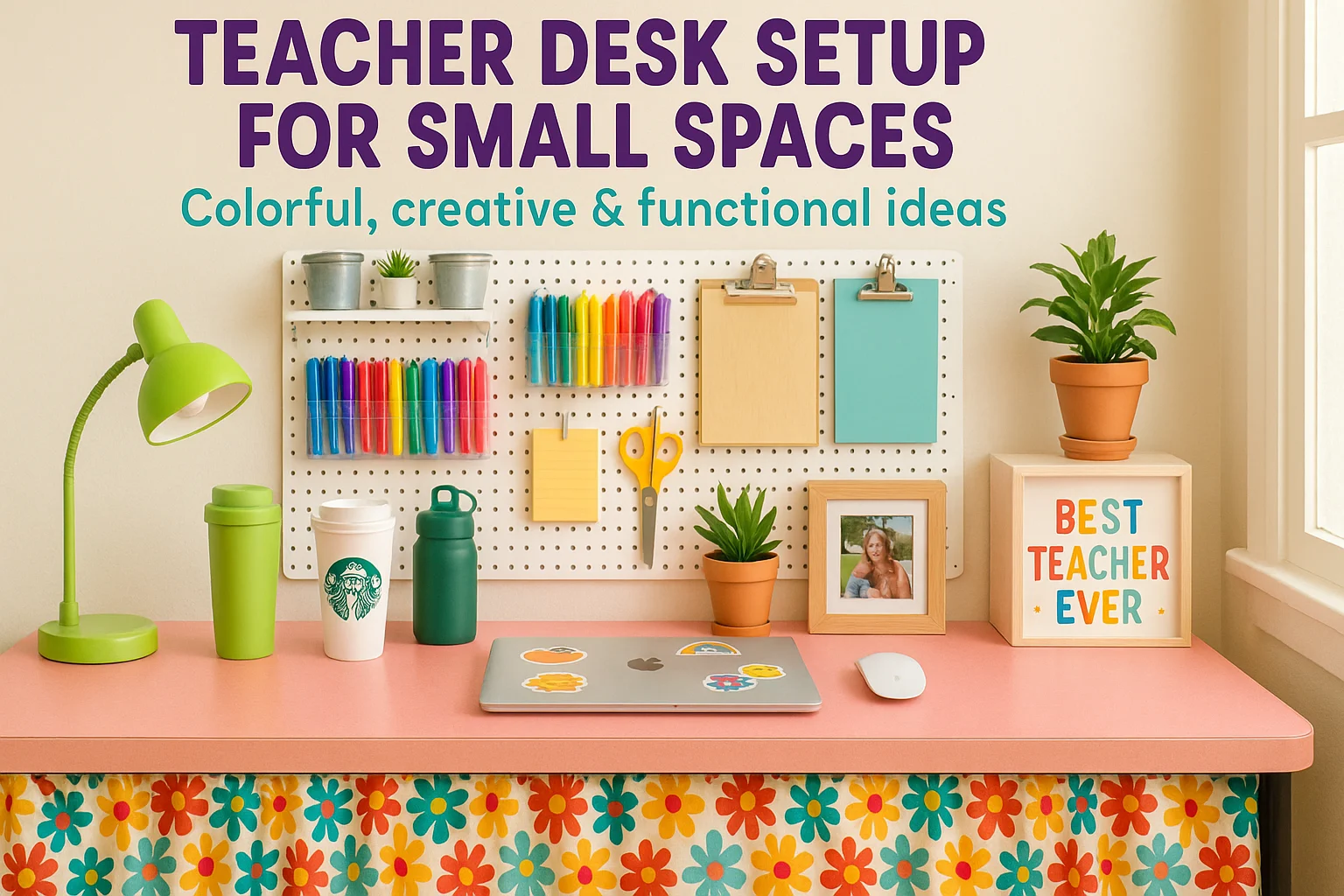Your cart is currently empty!

Habits of Organised Teachers Who Work Smarter, Not Harder
Want to look like the most organised teacher in the room without extra work? Here are 21 clever habits of organised teachers who know how to get things done with minimal effort.
This post may contain affiliate links. At no cost to you, I may earn a small commission if you click on any affiliate link within my blog.
Ever wonder how some teachers always seem calm, prepared, and effortlessly in control, without breaking a sweat? The secret isn’t working harder; it’s developing smart, time-saving habits of organised teachers.
They know how to streamline their workflow, set boundaries, and create a structured classroom without unnecessary stress. And they’ve mastered the fine art of looking organised while doing the bare minimum necessary to keep things running smoothly.
How do I know? Because as a veteran teacher of more than 25 years, I’ve learned a few ideas along the way. They don’t all always work. But they are a great bank of ideas to call upon when needed.
In this post, there are 21 habits of organised teachers that might help you stay on top of your workload while still having time for yourself.
If you’re ready to work smarter, not harder, let’s dive in! Starting with…
1. Reuse the same lesson plan slides every year – just tweaks the dates.
Why reinvent the wheel? A simple folder system and a quick edit make lesson planning a breeze.
- Keep a digital folder labeled by year to make quick updates.
- Use the same structure for each topic, just with fresh examples.
- Leave a few adaptable slides ready for future use.
2. Have a “good enough” grading system – no over-explaining feedback.
Efficient teachers don’t waste hours writing detailed essays on student work.
- Use a simple rubric instead of rewriting the same feedback.
- Highlight common mistakes on a template.
- Save a set of pre-written comments for quick copy-pasting.
3. Use a seating plan until it stops working.
If it ain’t broke, don’t fix it.
- Only move students when absolutely necessary.
- Keep a printed version for quick reference.
- Allow students to work in groups of their choosing on other tasks at other times.
4. Keep a stash of emergency worksheets for “just in case” lessons.
No-prep, always-relevant activities are a lifesaver.
- Have a folder labeled “Sub Plans” ready to go.
- Use open-ended tasks that work for any topic.
- Always keep a printed set of extra copies for absent students.

5. Have a standard response for student excuses – no debating.
No need for a long discussion, just keep it simple.
- “That sounds frustrating. Let’s work on what you can do now.”
- “I understand. If it’s not done today, you can finish it at recess.”
- “I hear you. Let’s move forward.”
6. Use email templates for common parent responses.
A well-prepared teacher never types the same email twice.
- Save draft responses for late assignments, behaviour issues, and general inquiries.
- Keep a draft email with placeholders for quick personalization.
- Store replies in an “FAQ” folder to copy-paste when needed.
7. Assign self-marking quizzes whenever possible.
Let technology do the work!
- Use Google Forms or Kahoot for quick assessments.
- Keep a few “always ready” online quizzes for review sessions.
- Use auto-marking multiple-choice sections for larger tests.
8. Never write the date on the board, students can figure it out!
Students have brains. Let them use them.
- Tell students, “Check the clock.”
- Keep a laminated “Write the Date” sign for a student to fill in.
- Have the date on a daily slide so it’s always there.
9. Use the same five “go-to” engagement strategies over and over.
Why complicate things? If it works, keep using it.
- Think-Pair-Share for quick discussions.
- Image analysis: Share an image related to the topic and ask students to analyze and interpret it.
- Four Corners for class opinions and movement.

10. Mark student work during class while they’re working.
No need for after-hours grading marathons.
- Circulate and give verbal feedback instead of collecting everything.
- Stamp completed work so students see progress.
- Use a highlighter to mark key areas instead of lengthy comments.
11. Have a “student helper” system to minimize admin tasks.
Let them take ownership!
- Students take attendance while the teacher sets up.
- Classroom jobs like “Tech Monitor” or “Paper Passer” keep things moving.
- Use a rotating system so students expect to help.
12. Only update classroom displays once a term (or never).
Minimal effort, maximum effect.
- Use neutral, long-term posters that don’t need constant updating.
- Have a “Student Work of the Month” section to change one thing, not everything.
- Use digital displays instead of printed ones.

13. Use explicit teaching – clear instructions, worked examples, and minimal fluff.
Teaching doesn’t have to be complicated.
- Begin lessons with “Today, we are learning X” statements.
- Model exactly how to complete a task before students try it. See this post for explicit teaching tips!
- Use a simple slide layout with key points, no overwhelming graphics.
14. Write vague sub plans so they can be used any time.
No need to overcomplicate it.
- Leave a general “review past work” instruction for subs.
- Have a “finish any unfinished tasks” option.
- Use open-ended activities that don’t require context.
15. Stick to routine – students always know what to expect, so less time is wasted.
Predictability keeps things running smoothly.
- Start every lesson with a set warm-up.
- Follow a structured lesson flow: intro → model → practice → review.
- Use clear, repeated pack-up and transition routines.
16. Have a stockpile of last-minute lesson ideas that always work.
No prep? No problem.
- Use “Summarize in 3 sentences” as a quick time-filler.
- Keep a stack of generic reading comprehension tasks.
- Have “Teach the Teacher” as a go-to activity when lessons finish early.
17. Ask one great question instead of leading a chaotic discussion.
Less is more.
- Use “What’s the most important thing about X?” instead of open-ended questions.
- Think-Pair-Share ensures every student processes before speaking.
- End the lesson with “What’s one useful thing you learned today?”
18. Use retrieval practice instead of cramming new content.
A little review goes a long way.
- Start lessons with a 3-question review.
- Use mini whiteboards for rapid recall.
- End lessons with a “Brain Dump.”
19. Use the same end-of-term activities every year.
Because they work.
- Keep a folder labeled “Last Week of Term” with all the go-to activities.
- Run a “reflection and goal-setting” task that requires zero prep.
20. Have a standard “calm down” look that gets instant results.
No words needed.
- Give “The Look.”
- Use a simple pause and silence to regain control.
- Move closer instead of raising your voice.

21. Leave work at work – no after-hours grading marathons.
The ultimate lazy-but-organised move.
- Prioritize what actually matters – not busywork.
- Grade efficiently in class.
- Set hard boundaries: “No school emails after 4 PM.”

If you’re ready to set better boundaries and create a calmer, more organised teaching life, don’t forget to grab my free guide: 10 Quick Reminders for Calm and Clarity at Work. It’s packed with simple, actionable tips to help you stay focused, manage stress, and leave work at work. You deserve a teaching life that doesn’t take over your personal time. Download it now and start making small shifts that lead to big changes!
Key Takeaways from This Post:
- Being organised doesn’t mean working harder.
- Teachers who look effortlessly in control rely on systems, routines, and simple hacks to minimise effort while maximizing effectiveness.
- Consistency and efficiency are the secret weapons of organised teachers.
- Reusing lesson plans, sticking to predictable routines, and automating tasks (like grading and emails) help cut down unnecessary work.
- Boundaries matter – leave work at work.
- The most efficient teachers prioritise what truly needs to be done and let go of perfectionism, ensuring their work doesn’t take over their personal life.
These 21 habits of organised teachers are about using simple, effective strategies to stay on top of things without stress. They prove that you don’t have to spend endless hours planning, grading, or reinventing the wheel to create a structured, effective classroom.
By using tried-and-true strategies, embracing routines, and letting go of unnecessary workload, you can create a calm, organised teaching experience without sacrificing your personal time.
Which of these habits do you already use?




